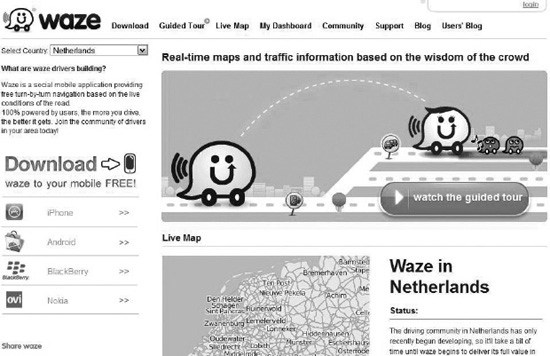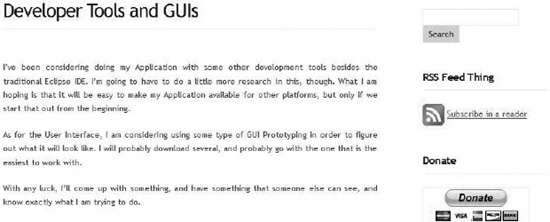Your Application’s Web Site
As cool as your application is going to be, it really is rather limited. One of the things that you will learn as a developer is that the less memory an application takes, the better. The challenge is how to take what memory you have to work with and make something of good quality and with many features. That is definitely a programming skill, but if you can’t find space for something in your application, why not put it on the official web site?
Since entire books have been written about web site construction, I see no point in going into detail about how to create a cool web site. If you’re thinking that there is no wrong way to do a web site, then you’re mistaken. I’m sure that you have been to cobweb sites that are full of broken links, and look like they have been long since abandoned by their creators. Yes, the Web is full of sites that have their “newest” content dating back several years ago.
The first thing that you should know about creating a web site is it takes time, and I am not talking about the initial creation. I mean the upkeep that must be done on a daily basis to ensure that the content is fresh. If visitors find that the content is not consistently updated, they are less inclined to return.
In addition to having a web site that is full of timely material, you definitely want to have a web site that matches the style of what you are doing on your application. Here is where you will implement your icon, logo, and many other stylistic aspects of your application. You might want to go to the Android Market and select an application. Under each of them should be a link to the developer’s web site, which will often be the official web site of the application. Go on and click on a few for yourself so you can see what they look like. For example, Figure 3-5 shows the Waze web site.

Figure 3-5. This is official web site for Waze. It has a lot more to offer than its mobile application.
In many cases, an Android application is just a mobile version of the site. Its sole purpose is to draw the user to the site itself, where the “real action” takes place. In other cases, the web site feels like something that was developed as an afterthought, when the developer realized that he or she was going to need one.
Let’s take a closer look at one example of a developer’s web site. You can see that most of these have a blog, community, and much more. Your application is your culture, and your web site is essentially your clubhouse.
The web site is probably the very place where you will first introduce your application, and people could discover what you are doing there. Notice that I say “could,” as most web sites are not discovered by accident. Yes, it will probably take some marketing and spreading the word so that people will learn that your site is out there. I’ll get to that in other chapters, but let’s talk about the next step.
Setting Up Your Web Site
The first thing that you will need for setting up a web site is a domain name. Hopefully, you can ensure that it is the same as your application’s name. I have already covered some of that in Chapter 2, under the question of “What will you call your application?”
Once you have your unique URL picked out, you will need to find a web hosting service. You could go with GoDaddy.com, Google Sites, or other such ventures, and you should expect to pay a monthly fee. From there, you can access a service known as WordPress that allows ordinary people without much programming experience to create some professional-looking web sites. It does so using templates, and you will find that you can toy with them until you find the precise style that you are looking for. As a professional blogger, I have found that most people tend to use WordPress to set up blogging sites. It is very easy to create new postings, and you can set it up to allow outsiders to post. It is also easy to add pictures, links, and other necessary features to a posting.
While I am on the subject of blogging, your web site is also a place where you can start your blog. Blogging is a good way of showing people that you are working on your application. The format of blogging is often a devil-may-care style of writing, so Figure 3-6 might be a typical blogging entry.

Figure 3-6. What a blog entry from an application’s web site might look like. This one was made with WordPress.
Note that the way the post is written conveys that you are a human being as well as a developer. It shows that you are trying to make something work, not just trying to do something that will make money. You might also notice that there are things that you don’t want to put in a blog, even though they are true. You might not want to state that a certain company that you are working with is giving you a hard time, as this hurts the reputation of the company. Also, you might want to avoid NSFW (not suitable for work) language.
Blogging is also an excellent way of unofficially tracking your progress. Note my use of the word “unofficially.” You will definitely want to track the progress of your application’s building, launch, and all marketing before and after. There are several reasons for this, and many of them have to do with keeping adequate records for tax time or an IRS audit.
By the way, if you are not an official business, then you should be. If you are in the United States, then you will have to apply with your state’s Secretary of State. This can be easily done online, and if you perform a search for your state’s Secretary of State, then you should find the documents that need to be filled out to declare yourself a business. I applied as a content writer, but you can apply as a developer or some similar business. The point is that you want the official license, which will cost you a little bit of money depending on what state you reside in. You should take care of this before you get out your first application to the market, as you might want to list a business for the application developer on the Android Market.
Your web site is one of the best tools for creating a following. You’ll definitely want to include a community forum on your site. It is easy to create one of these in order to generate some chatter when it comes to your application, even before it launches. I’ll go into greater detail on that later in this book, including a discussion on press releases and other communication to the public.
Notice that most web sites have a FAQ. Granted, you won’t have any customers before you officially launch your application, but perhaps you can arrange some answers to the question of when your application will be launching. You might also want to answer questions on other platforms that it will be available for, projected cost, and other issues that a potential user would want to know about. Also, you could make a blog entry explaining to readers that you are working on an FAQ section, and you want to see questions for it. You will hear me repeat this several times within this book, but take advantage of any stage that you can stand on. In the case of your application, your web site is the center stage, so put your best work there.
